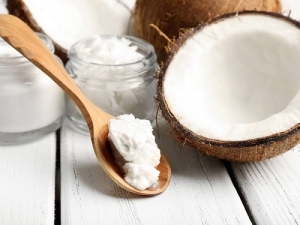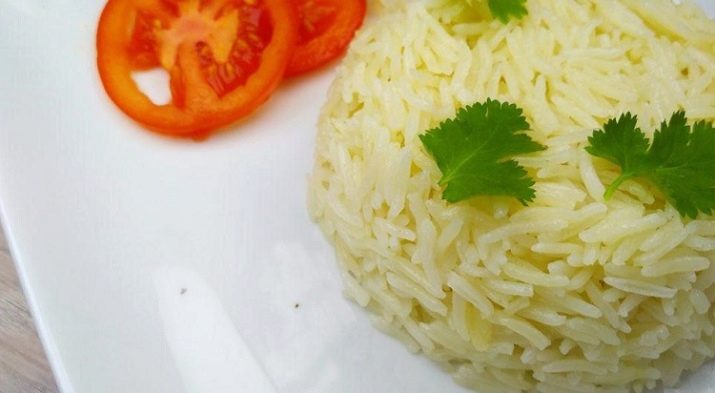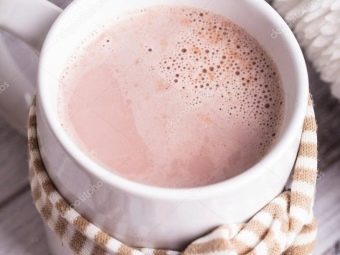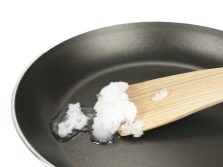Coconut oil for food: benefit, harm and use

Coconut oil as a food product causes a lot of controversy among both the inhabitants and among nutritionists.The basis of the product is coconut pulp, which can be fresh or dried (it is called copra).
Composition
Most of the composition (about 99%) is fatty acids. Among them are polyunsaturated fatty acids (these are well-known to all Omega-3, -6), monounsaturated (nerve, oleic, palmitoleic acid) and saturated fatty acids (butyric, stearic, caproic and others). Tocopherol (vitamin E), phytosterols, as well as zinc, calcium, phosphorus are present in small amounts in the composition of the product. The minimum amount (about 1%) contains water.
The energy value of the product is quite high - 900 kcal / 100 g. However, in such quantities the product, of course, is not eaten at once, therefore such a high calorific value does not seem so terrible. In a tablespoon - about 130 kcal. The basis of BZHU-composition - fats (99.9%), proteins and carbohydrates are absent.
What is useful?
Coconut oil is characterized by the fact that when heated does not emit carcinogen and almost does not change its composition. This allows it to be used for frying. Possessing an enveloping property, the product improves the condition of the gastric mucosa, eliminates small inflammations. It is useful to serve spicy, spicy foods with it, as it will neutralize the aggressive effects of spicy foods. In addition, coconut oil has an antiseptic effect and helps to improve the absorption of nutrients from food.
The beneficial effect of the product is found on the liver - the organ's ability to self-purification, the level of bile produced increases. Despite the abundance of fatty acids, the coconut product does not cause an increase in cholesterol level; on the contrary, it strengthens the cardiovascular system, reducing the risk of developing heart attack and atherosclerosis. When used moderately it helps to reduce high blood pressure.
Fatty acids are essential for proper metabolic processes. From the stomach, these components are sent straight to the liver, where they decompose and transform into ketane bodies. The latter are important for the normal functioning of the central nervous system, especially the brain. In addition, according to the research, ketan bodies are able to block the feeling of hunger and increase energy consumption by 3 times during metabolic processes. In other words, with the right approach to the use and nutrition in general, coconut oil, despite its high calorie content, can be used for weight loss.
More than half of the composition of the product "given away" lauric acid. During cleavage, it is transformed into monolaurin (a similar compound is present in breast milk), which has pronounced antiviral and antifungal properties. In this regard, it can be argued that regular consumption of coconut oil can increase the body's resistance to viral infections, including colds, SARS.
Lauric acid also contributes to the increase of "beneficial" cholesterol in the blood and reduces the level of "bad". Monolaurin in combination with caprylic acid suppresses candidate fungi (namely, a large number of them in the intestine explains a person’s constant desire to eat sweets) and supports beneficial intestinal microflora, improves digestion. And in combination with vitamin D, this same monolaurin strengthens tooth enamel.
Fatty acids allow you to better absorb calcium, magnesium and several other trace elements, so it is useful to combine it with vegetables and fruits, meat, fish. In addition, fatty acids themselves are necessary for the structure of the skeletal system.
Especially useful product for women, since the combination of tocopherol and fatty acids is necessary for the functioning of the reproductive system. Its components contribute to the development of female hormones, stabilize hormones. The lack of fat and vitamin E in the body results in such unpleasant external changes as dry skin, brittle nails and hair, dull complexion.Vitamin E has a powerful antioxidant effect, removing toxins from the body and reducing the intensity of age-related cell changes.
Contraindications
The high calorie content of coconut oil makes it an unsuitable product for people with obesity, overweight. With pancreatitis, the product should be used with caution, it is better to consult with your doctor first, since exacerbations of the disease are not excluded.
Individual intolerance of the product, irritation of the gastric mucosa and cholecystitis - all this is a contraindication to the use of coconut oil. It is fair to say that the product is considered hypoallergenic, however, if you are allergic to nuts, most likely, and the oil will not be taken by the body.
Excessive use of the product, of course, will only harm. It can provoke nausea, abdominal pain, and stool disorders. The permissible daily dosage for an adult subject to the absence of contraindications is 3 tablespoons, for the elderly, it drops to 1 tablespoon, for children - to a teaspoon.
What oil can be eaten?
Coconut oil can be prepared by one of three methods - cold pressing, hot pressing and roasting. It is recommended to use a cold pressed product for food, which is pressed in a centrifuge without the use of high-temperature exposure. The oil produced in this way can be identified by the inscription Virgin and Extra Virgin on the package.
In such a product there are no carcinogens and harmful compounds, the maximum concentration contains nutrients. Coconut aftertaste and aroma are also indicative of naturalness. Not surprisingly, cold-pressed oil has the highest cost.
Hot-pressed product is better not to be eaten, but used for cosmetic purposes. This oil is prepared from dried coconut pulp, which is pressed in a centrifuge under a hot press. In this regard, some of the useful elements are destroyed, and some of them are transformed into carcinogenic compounds. In terms of its taste, such a product is significantly inferior to the cold-pressed analogue, it does not have the pleasant aroma of coconut.
Oil obtained by frying, should not be used not only for food, but also for cosmetic purposes. The technology of its production involves the drying of the pulp and its subsequent roasting, during which the oil is released. Such an aggressive thermal effect does not allow useful elements to remain in the oil. As a rule, such a product has a low price. In Russia, the supplier of such oil is usually Thailand.
The next indicator of the usefulness of the oil - the degree of purification. Refined (purified) and unrefined (unrefined) oil is isolated here. During cleansing, the oil loses most of its useful components, in addition, after cleaning it is often deodorized (that is, bleached), adding "chemistry". Turns out that only unrefined cold pressed coconut oil is beneficial.
However, the inscription “refined” does not mean that the oil is not suitable for use, it just will bring less benefit. There is also a “highly refined” product, which means that lauric acid was removed from it during the cleaning process. Such oil can be both used in food and used for cosmetic purposes.
But from the purchase of a product labeled "fractional squeezing" should be abandoned, because its composition is represented exclusively by fatty acids. This oil is approved for use in perfumes and soap.
Cooking recipes
Coconut oil can be consumed in two ways - in its pure form and added to various dishes. In the first case, the oil is used to treat certain diseases, weight loss. Take it 1-2 tablespoons on an empty stomach half an hour before breakfast, washed down with warm water.It is necessary to begin reception with half a teaspoon, gradually increasing the dosage.
Most say that this procedure is unpleasant, and the specific taste of the oil on an empty stomach causes nausea. It is much more pleasant to use it in combination with familiar dishes. In cooking, oil is used for frying various dishes, dressing salads and porridges, put into the dough (shortbread dough with coconut product becomes juicier, and biscuit - softer), prepare sauces. We present the most interesting recipes using coconut oil.
Salads
The most logical way to fill the coconut oil salads. However, it should be remembered about its features - freeze at + 22.25 ° C, therefore, refueling should not be cold.
- Prepare a salad from a single cucumber and a pair of tomatoes, add onion chopped into slices of avocado and half-rings, add a little cheese. Heat 2 tablespoons of coconut oil, pour a teaspoon of freshly squeezed lemon juice and season the salad.
- A more nutritious salad option involves a combination of lettuce leaves, boiled seafood (you can take canned), Cherry tomatoes. Here you should also add olives cut into slices and onion rings. Season with a mixture of honey, lemon (a teaspoon) and melted coconut oil.
- Sweet with coconut aroma oil goes well with fruit salads. To make one of them, mix sliced orange, apple, kiwi, pear and banana. Refill to make from coconut oil and honey. Decorate with pomegranate seeds or mint leaf.
Soups
Coconut oil will accentuate the taste of spicy thick soups, so professional chefs like to put the product in mashed soups. Let us give you a recipe for a fragrant autumn soup, which delights with its noble appearance and incredible taste. Pumpkin puree soup is made from the following ingredients:
- 1 kg of pumpkin pulp;
- 2 tablespoons of coconut oil;
- 1 liter chicken broth;
- 1 tablespoon of curry and cane sugar;
- teaspoon ground ginger;
- 3-4 cloves of garlic;
- ground cayenne pepper, salt, herbs - to taste.
In a saucepan for the soup, melt coconut oil and heat it, then introduce the diced pumpkin pulp and fry it for 6-8 minutes. Add cane sugar, ginger, curry and cayenne pepper, hold the pan on a slow fire for another couple of minutes. Pour chicken broth, chopped garlic and cook soup for 50 minutes. Add salt, beat pumpkin pulp with a blender. A little warm the soup on the fire and serve, garnish with greens.
During the final warming up, you can pour in 20 ml of cream for a more delicate flavor.
Side dishes
Coconut oil can be filled with any cereal, and when cooking mashed potatoes, replace them with butter. Since the coconut product does not emit carcinogens when heated, you can fry potatoes and pasta on it. Here we give a recipe for cooking crumbly rice, which is a universal garnish. Crumbly rice with coconut oil can be prepared by taking:
- 3 tablespoons of coconut oil;
- 200 grams of rice;
- 400 ml of water;
- 1 teaspoon of cardamom, turmeric and coumarin;
- salt to taste
Rice must be taken long grain, transparent or glassy. The one for plov (Devzira, Basmati, Jasmine), as well as croup processed with steam, will do. Rice should be washed thoroughly beforehand, and then soaked for 2-3 hours in cool water. Steamed cereals can not be soaked, well enough to wash. In a thick-walled pot or cauldron, melt and warm the butter, put the rice prepared in advance. Add spices and salt, pour in water.
First, make the fire strong, but as soon as the water in the pot begins to boil, reduce the flame to a minimum and simmer the rice for 30-40 minutes until ready under the lid. Cover the finished rice with a lid, top with a warm towel. Let stand a quarter of an hour, then serve.
Baking and Drinks
Coconut oil can be replaced with butter or margarine in baking. The article focuses on the original recipe for banana fritters. Ingredients:
- 1 ripe large banana;
- 200 ml of milk;
- 100-150 g of flour (how much will take the dough);
- 2 tablespoons coconut oil;
- teaspoon ground cinnamon.
To break a banana into pieces, add milk and turn it into a smooth mush using a blender. Add melted coconut oil, add cinnamon, and then flour. You should get the usual consistency of dough for pancakes. Optionally, you can add a little sugar, but the sweetness of a banana and butter should be enough. Fry the pancakes on a hot griddle on both sides. Butter will help to give your usual tea or coffee coconut notes. The drink will turn out "winter", warming. Do not forget that his caloric content will increase markedly.
Habitual cocoa can be turned into a more delicious and original drink. To do this, heat a glass of milk, add 2 teaspoons of cocoa powder, a teaspoon of coconut oil, add sugar to taste, a little vanilla and coconut. Warm up the mass, but do not let it boil. Remove from heat and serve.
How to choose and store?
As already mentioned, the body can only benefit from cold-pressed oil, which can be recognized by the inscriptions on the packaging of Virgin or Extra Virgin. If the manufacturer indicates Coconut Oil, this means that coconut pulp oil is extracted using chemical solvents. Call it useful and safe for health can hardly be. Although a number of confectionery products contain such a product.
Choosing a product, you should pay attention to its color and texture. It should be transparent or white, uniform in structure, thick, but not viscous. But the presence of yellowness, golden precipitate indicates a low quality product.
Good coconut oil is characterized by a delicate flavor, it is what is called, it melts in the mouth and has a light nutty aftertaste. This oil also has a pleasant sweetish coconut smell.
As part of the product should be only coconut pulp. If you find in the list of ingredients thickeners, preservatives, dyes from the purchase is better to refuse. Finally, it should be understood that high-quality coconut oil of cold-pressed can not be cheap. First, this is due to a large amount of raw materials (with cold extraction from 1 kg of coconut pulp, a little more than 100 ml of oil is obtained, while during hot processing - about 300 ml), and secondly, the extra benefit that Extra Virgin oil has .
In the factory sealed container oil is stored for 2-4 years. Preference should be given to the product in a darkened glass bottle. It is important to keep the oil away from light and sunlight. The optimum temperature is no more than + 18 ° C, the level of humidity is not higher than 60%. It is forbidden to freeze butter. After opening the package, the oil should be kept in the refrigerator (ideally in a special compartment in the door).
Tips and reviews
According to reviews, the best coconut oil comes from India. Thailand produces a lot of fakes, as well as oil, obtained by frying. Butter, as already mentioned, can be put for baking. In addition, you can fry the same pies, cheese cakes, pancakes on the butter itself. At the same time, the oily taste will not be felt in the finished dish, but gentle coconut notes in the taste and aroma will be clearly felt. It is good to cook with coconut oil and popcorn, which makes it acquire a pleasant nutty aftertaste.
For sweet foods and drinks, it is better to choose unrefined coconut oil, which will give them a pleasant coconut flavor. In meat and fish dishes, in savory side dishes, such a smell may be superfluous, so preference should be given to the refined counterpart.
Those who are on a diet note that fresh and sometimes not the most delicious dietary dishes are literally transformed, just add a little coconut oil to them.However, for those who carefully control the weight, it should be no more than 1 tablespoon per day.
If you are prone to the formation of blood clots, then coconut oil is recommended to combine with olive or peanut. The important point is that they both should be cold pressed.
For more on how to use coconut oil, see the next video.






































